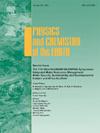Quantitative inversion modeling of surface gold abundance based on remote sensing imagery and geochemical Data: An example from Tasiast-Tijirit gold district, Mauritania
IF 3
3区 地球科学
Q2 GEOSCIENCES, MULTIDISCIPLINARY
引用次数: 0
Abstract
The Tasiast-Tijirit Terrane in northwestern Mauritania is an important gold mining district that mainly consists of igneous and metamorphic units that are thought to represent the remnants of older greenstone belts. Surface outcrops typically contain a high concentration of economically valuable elements. This study focuses on the quantitative inversion of auriferous soil and rock samples based on remote sensing data, highlighting the significance of using surface geochemical samples to delineate anomaly areas of gold mineralization in desert regions for effective mineral exploration programs. The backpropagation neural network inversion model was used in this work to quantitatively invert the soil and rock samples with spectral band reflectance of Landsat-7 ETM+ and GF-2 satellite imagery at 1:50000 and 1:5000 scale, respectively. Landsat-7 ETM+ was chosen because its spectral bands are almost identical to the GF-2 remote sensing data, allowing for a reasonable correlation between the datasets. Results indicate that the established model achieved R2 values of modeling and test sets are 0.65 and 0.63, 0.52 and 0.49 with RMSE values of 0.009 and 0.014, 0.034 and 0.055 for soil and rock samples, respectively, using Landsat-7 ETM+. Similarly, GF-2 imagery R2 values of modeling and test sets are 0.73 and 0.69, 0.60 and 0.57, with RMSE values of 0.005 and 0.004, 0.015 and 0.023 for soil and rock samples, respectively. The inversion modeling and predicted anomaly areas are well aligned with the geochemical exploration map and actual mining area. The findings suggest that although Landsat-7 imagery provides an overall distribution of surface gold elements, it is restricted in its ability to delineate high gold-rich zones in desert regions due to relatively coarse resolution besides the geological and environmental conditions such as wind erosion and weathering effects. Conversely, GF-2 imagery enabled precise delineation of the anomaly locations with rock samples, proving to be more effective owing to its higher resolution scale of 1:5000. Overall, the adopted innovative methodology that implements high-resolution satellite data with the bakpropagation neural network model promise to be very effective in enhacing minerals prediction accuracy and lowering the exploration costs.
基于遥感影像和地球化学数据的地表金丰度定量反演建模——以毛里塔尼亚Tasiast-Tijirit金矿区为例
毛里塔尼亚西北部的Tasiast-Tijirit地块是一个重要的金矿矿区,主要由火成岩和变质岩单元组成,这些单元被认为代表了更古老的绿岩带的残余。地表露头通常含有高浓度的有经济价值的元素。本文重点研究了基于遥感数据的含金土壤和岩石样品的定量反演,强调了利用地表地球化学样品圈定沙漠地区金矿化异常区域对有效找矿方案的意义。本文采用反向传播神经网络反演模型,分别对Landsat-7 ETM+和GF-2卫星影像在1:5万和1:50000比例尺下的光谱波段反射率土壤和岩石样品进行定量反演。之所以选择Landsat-7 ETM+,是因为它的光谱波段几乎与GF-2遥感数据相同,从而允许数据集之间存在合理的相关性。结果表明:采用Landsat-7 ETM+,所建立的模型对土壤和岩石样品的建模集和测试集R2分别为0.65和0.63、0.52和0.49,RMSE分别为0.009和0.014、0.034和0.055。同样,建模集和测试集的GF-2图像R2值分别为0.73和0.69、0.60和0.57,土壤和岩石样品的RMSE值分别为0.005和0.004、0.015和0.023。反演模型和预测异常与化探图和实际矿区吻合较好。研究结果表明,尽管Landsat-7图像提供了地表金元素的总体分布,但由于分辨率相对较粗,加上风蚀和风化等地质和环境条件的影响,它在描绘沙漠地区高富金带的能力受到限制。相反,GF-2图像可以用岩石样本精确地描绘异常位置,由于其1:5000的更高分辨率,被证明是更有效的。总的来说,采用的创新方法将高分辨率卫星数据与反向传播神经网络模型结合起来,有望非常有效地提高矿物预测精度,降低勘探成本。
本文章由计算机程序翻译,如有差异,请以英文原文为准。
求助全文
约1分钟内获得全文
求助全文
来源期刊

Physics and Chemistry of the Earth
地学-地球科学综合
CiteScore
5.40
自引率
2.70%
发文量
176
审稿时长
31.6 weeks
期刊介绍:
Physics and Chemistry of the Earth is an international interdisciplinary journal for the rapid publication of collections of refereed communications in separate thematic issues, either stemming from scientific meetings, or, especially compiled for the occasion. There is no restriction on the length of articles published in the journal. Physics and Chemistry of the Earth incorporates the separate Parts A, B and C which existed until the end of 2001.
Please note: the Editors are unable to consider submissions that are not invited or linked to a thematic issue. Please do not submit unsolicited papers.
The journal covers the following subject areas:
-Solid Earth and Geodesy:
(geology, geochemistry, tectonophysics, seismology, volcanology, palaeomagnetism and rock magnetism, electromagnetism and potential fields, marine and environmental geosciences as well as geodesy).
-Hydrology, Oceans and Atmosphere:
(hydrology and water resources research, engineering and management, oceanography and oceanic chemistry, shelf, sea, lake and river sciences, meteorology and atmospheric sciences incl. chemistry as well as climatology and glaciology).
-Solar-Terrestrial and Planetary Science:
(solar, heliospheric and solar-planetary sciences, geology, geophysics and atmospheric sciences of planets, satellites and small bodies as well as cosmochemistry and exobiology).
 求助内容:
求助内容: 应助结果提醒方式:
应助结果提醒方式:


